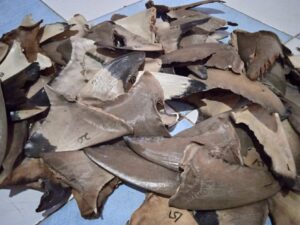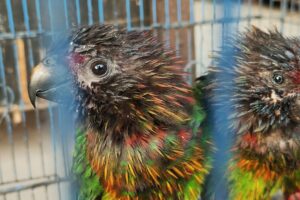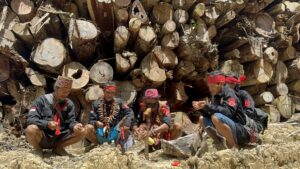Sunadi (not his real name) was shocked. He looked tense when he saw the signboard marking the boundaries between forest areas and oil palm plantations Buding Village, East Belitung, vanished. At that time, on September 22, 2022, the signboard had only been installed there for two days.
The palm oil plantations are owned by PT Steelindo Wahana Perkasa (SWP) and PT Parit Sembada (PS), a subsidiary of Kuala Lumpur Kepong Berhad (KLK).-
“We don’t know who removed the signboard, whether it was the forestry department or the company,” the former PT SWP worker said after 10 minutes of searching for traces of the missing signboard. He only found the wood that was previously used as a stand for the board.
Earlier, the signboard that separated oil palm land from forest areas was deliberately installed by the Forest Police together with the East Belitung Environment Office. The fence was planted at the coordinates of S-2°45, 404, E107°59, 936.
Putting up the signboard is the aftermath of the protests by villagers, who rejected the extension of the land use rights (HGU) of the two companies issued in 2017. “This area is rightfully a state forest,” Sunadi told Jaring.id and Katadata on Tuesday, December 20, 2022. He was showing the boundaries of the forest area that should not be planted with oil palm.
In Belitung Island, this giant Malaysian company has several oil palm plantation subsidiaries operating across East Belitung and Tanjung Pandan. The company’s 2020 report stated that KLK’s total land area in Indonesia is almost 114,000 hectares. In this area, the company runs its production activities, from upstream to downstream, producing 597,961 metric tons of CPO. Its main markets are countries in Asia and Europe, such as China, India, Pakistan, the Netherlands, and the UK.
Only a small portion of the hundreds of thousands of hectares of land is marked as a protected forest area. Based on the Decree of the Minister of Environment and Forestry Number SK.1940/MENLHK-PKTL/KUH/PLA.2/4/2017, the palm oil lands of SWP and PS are included in the Gunung Sepang protected forest, while other points spread from Buding Village to the border of Parit Sembada and Steelindo plantations.
Jaring.id had traveled the boundaries of protected forest areas in Belitung for a week and found at least 30 forest areas had been planted with oil palm trees. The total area of protected forest encroached for the plantation reached 500 hectares, consisting of Gunung Sepang Protected Forest covering 388,11 hectares, Teluk Pring-Bukit Nayo 92 hectares, and Kik Karak reaching 7.6 hectares.
Jaring.id observed that the forest area that has been planted with oil palm is separated by a path, which is used as the distribution route. A row of palm trees as high as five meters, which are estimated to be 15 years old, stood neatly in the area. Several workers were seen taking care of the trees from the side of the path by cutting the fronds and sprinkling fertilizer. Without the use of GPS, it would be difficult to find the boundary between the forest and the oil palm plantation. The road seemingly used to be the boundary between the two. The protected forest is on one side, while the other side is the oil palm plantation.
“But now, the boundaries have been removed. PT PS and PT SWP have left it all to the state,” said Mardani, Buding Village Head, when interviewed at his office on Wednesday, December 24, 2022.
The residents of Buding Village, according to Mardani, could only wait for the government’s decision regarding the utilization of land that has already been planted. He hopes that the planted area in the forest can be managed by the local community. If not, then the residents will adamantly refuse the extension of the land use rights of Steelindo and Parit Sembada. “We are waiting for regulations from the local government. They are still discussing it with the province on what to do and how should we use the land,” he said.
Community Rejection
Two years ago, the Indonesian Village Apparatus Association (APDESI) reported alleged forest encroachment to the Belitung Timur Resort Police with the Report Number LP B/369/II/2021. APDESI alleged that a Malaysian palm oil company had violated Law Number 18 of 2013 on the Prevention and Destruction of Protected Forests.
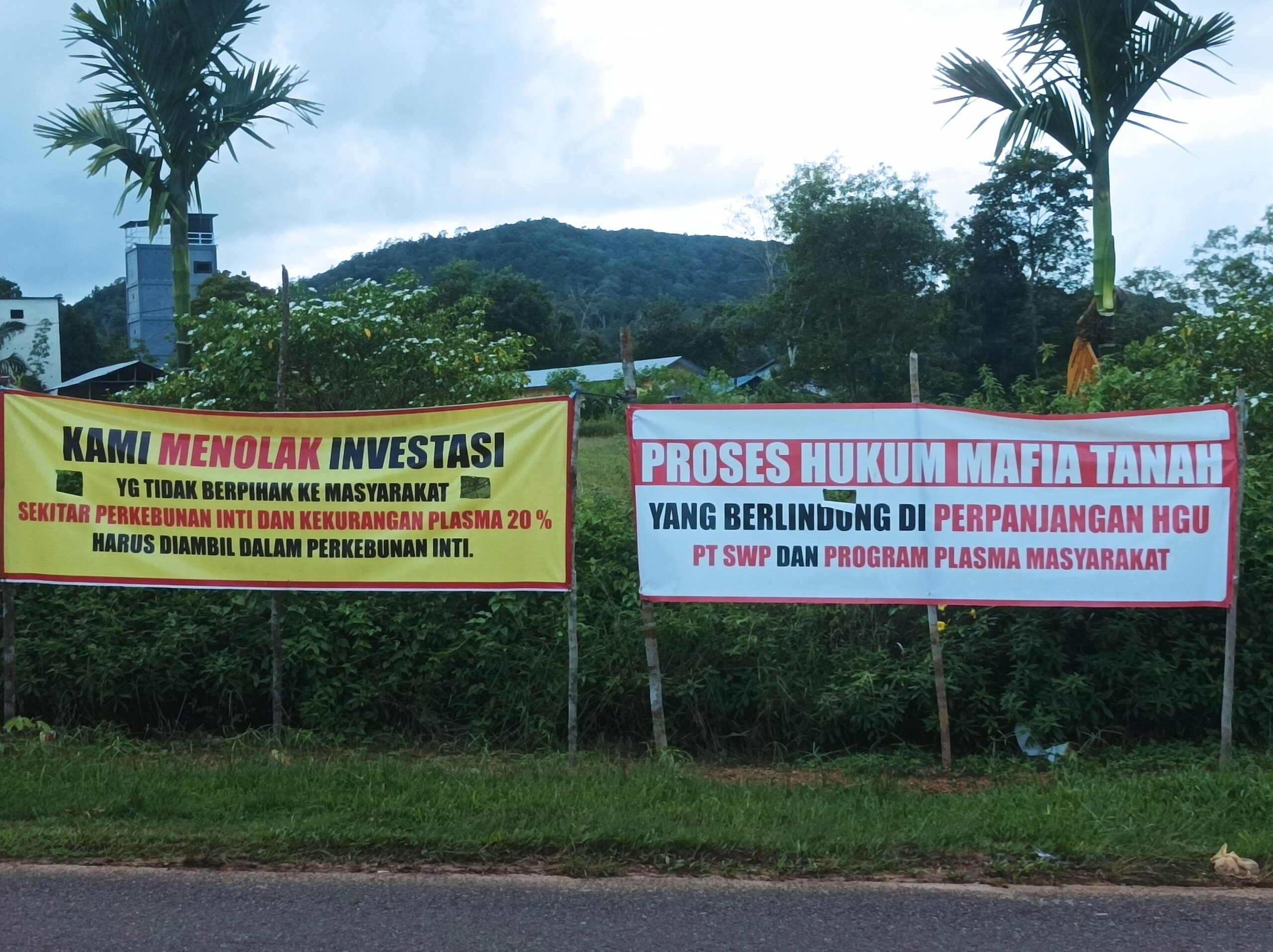
During the investigation process, the police found a number of alleged violations. Two of them were related to forest area encroachment, in which the perpetrators carried out activities in the area without obtaining a Forest Area Utilization Permit and plasma utilization.
Adj. Sr. Comr. Taufik, the East Belitung Police Chief, handled the case at the time. He said the police had asked the company not to carry out any activities in the area. “In December, we asked the company to stop their activities. We told them to stop because of the status quo,” he said when interviewed at his residence, Thursday, December 15, 2022.
However, he said, the company was unmoved. Finally, the police continued the process by imposing administrative sanctions. Taufik suspected that the company violated the Job Creation Law related to the utilization of forest areas. In addition, the police also considered that the company violated Law No. 17/2012 on Cooperatives. “We impose administrative sanctions, but they didn’t obey it, so they didn’t take any action to improve,” said Taufik.
Now, the police are still investigating the forest encroachment case. “I will convey it to my successor,” said Taufik, who has now been transferred to Bangka Police Station.
The spokesperson for PT Steelindo Wahana Perkasa cum PT Parit Sembada, Ikhsan Nurhadi, did not deny the overlap between land use rights (HGU) and forest areas. However, we used only a small area of the forest. It was on the edge part, and we didn’t harvest the oil palm. We were still in doubt about whether the area was included in our HGU or not. We’re still investigating it,” Ikhsan said when interviewed in his office on Thursday, December 24, 2022.
Even so, the company refused to be blamed for the alleged forest encroachment. “We did not enter the forest area, but the forest area shifted to the area that is still included in our area based on our HGU,” he emphasized. For the sake of legal certainty, both PT SWP and PT Parit Sembada are submitting claims to the Forest Area Stabilization Center (BPKH). If they do not get a solution, then the company will file a lawsuit. “Because this issue must be decided legally based on the trial. If there is a final ruling that decides the area does not belong to our HGU, then we will release it,” he said.
As long as there is no permanent decision, Ikhsan hopes that no party, neither the government nor residents, would claim the oil palm plantation as a forest area. “The sign was installed, then we explained that we are currently in the process of claiming this area through BPKH. We coordinated with BPKH and the letter was forwarded to the province, then the sign was removed again, and the land is currently awaiting the claim process,” he explained.
Director General of Rights Determination and Land Registration of the Ministry of Agrarian Affairs and Spatial Planning/National Land Agency, Husaini, invited the company to file a lawsuit against the government’s decision. “Go ahead and file a lawsuit, that’s even better,” he said in an interview at his office on Monday, December 26, 2022.
Based on Decree Number 5/HGU/KEM-ATR/BPN/I/2023 concerning the Extension of PT Steelindo Wahana Perkasa’s Land Use Rights in East Belitung Regency, Bangka Belitung, the government confirmed that hundreds of hectares of PT SWP’s land are indicated to be in the forest area. The area consists of 487 hectares, which is divided into 388 hectares intersecting with the Gunung Sepang Protected Forest, 92 hectares entering Teluk Pring-Bukit Nayo Protected Forest, and 7.6 hectares intersecting with Gunung Kik Karak Protected Forest.
The decision was based on a letter from the Head of the XIII Forest Area Consolidation Center, Directorate General of Forestry Planning and Environmental Management, Ministry of Environment and Forestry on November 18, 2020. The letter, numbered S.501/BPKH.XII-3/2020, states that the Attachment Map to the Minutes of the Definitive Boundary Layout of the Gunung Sepang Protected Forest Area on March 17, 1990, was approved on February 24, 1990. The protected forest in this area was determined to be 173 hectares, and the attachment to the definitive map of the Teluk Prong Bukit Nayo Protected Forest on March 20, 1995, stated that the forest area covers 111 hectares. Meanwhile, PT SWP’s initial HGU permit was only issued in 1998.
Oil Palm Plantation Causes Animal Extinction
Spanning across more than 4,800 square kilometers, Bangka Belitung Islands is a large province that connects Sumatra, Kalimantan, and Java. Besides having a metal industry, Bangka Belitung is rich in flora and fauna, both on the land and the water. The island is also a habitat for protected animals, especially mentilin or Bangka tarsier, slow loris, and binturong. However, since the island’s tin was exploited and the land was cleared for oil palm plantations, these typical Belitung animals are no longer found.
On Wednesday night, December 28, 2022, Jaring.id spent some time looking for the tarsier by exploring the border of the oil palm plantation to the Gunung Sepang Protected Forest. Located about 79 kilometers from the Steelindo Wahana Perkasa and Parit Sembada plantations, the team was in the 115-hectare Peramun Forest Area. Despite the rainforest having abundant biodiversity, the journey to spot the endemic species was fruitless. There was only a flock of long-tailed monkeys hanging around and occasionally foraging for food.
Sunadi, who has lived for 54 years in Buding Village, Kelapa Kampit, East Belitung, said that he rarely sees endemic animals. In the past, he often encountered the Bangka tarsier. “It’s hard to find mentilin now, but sometimes we happen to come across one,” he said.
Mentilin is a round-eyed nocturnal animal. This smallest mammal is only easily found at night between 7 pm to 10 pm. As long as it opens its eyes, it always seems to be bulging. In fact, the size of its eyes is almost as big as its entire brain. Its eyeballs are about 16 millimeters in diameter. It is known by the scientific name Cephalopachus bancanus or Horsfield’s Tarsier, a primate from the Tarsiidae family. It is the identity fauna of Bangka Belitung Province, based on the decision of the Minister of Home Affairs Number 522.53-958/2010.
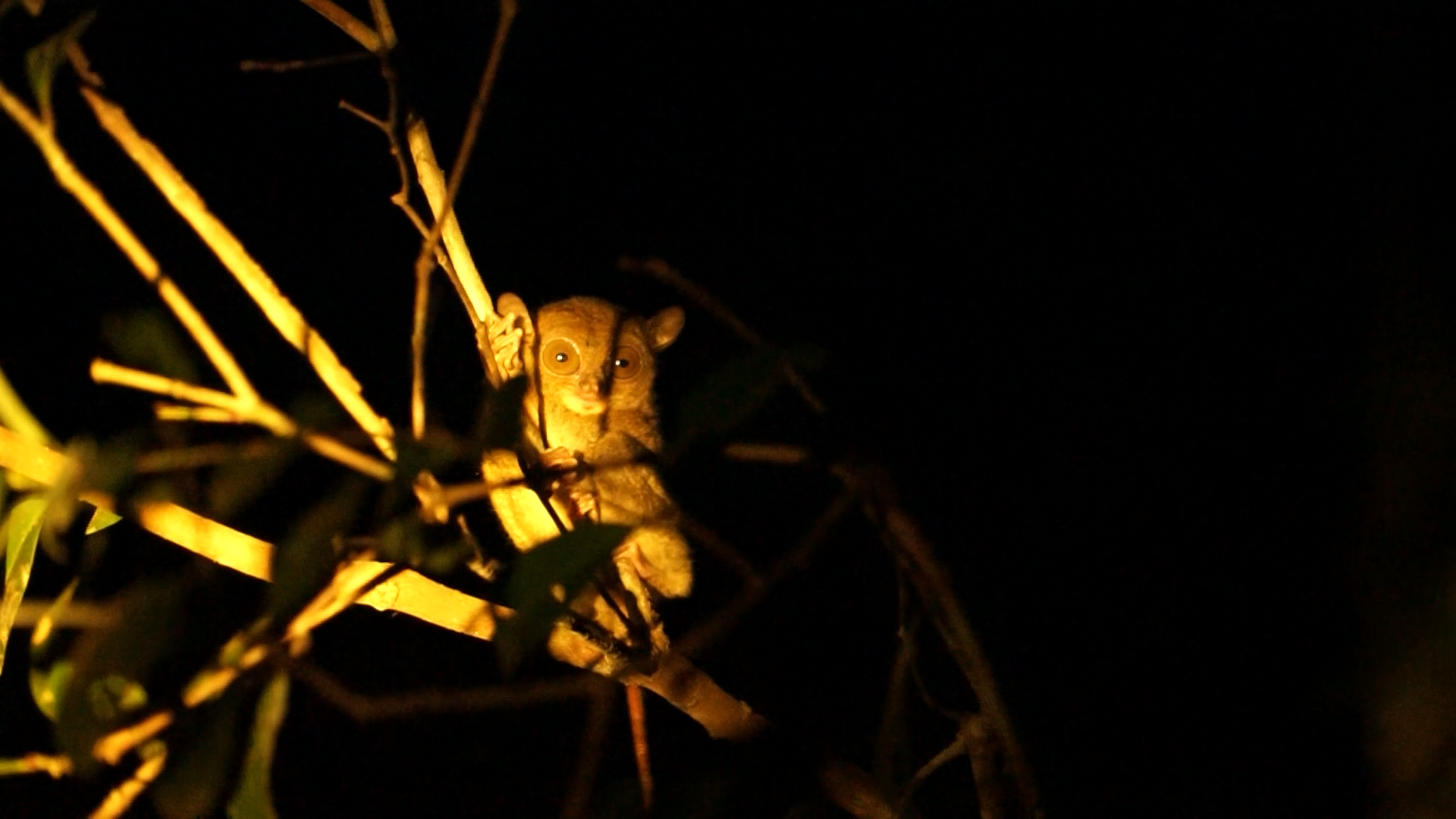
Long before palm oil plantations were opened, according to him, the native Belitung animal often wander around in the area not far from his village. Apart from having a natural dam and flowing river, the area is fairly abundant with tarsier foodstuffs, such as crickets, insects, mosquitoes, and caterpillars. “Now the area has turned into oil palm plantations. That’s why the tarsiers are extinct and hard to find,” he said.
Mardani, Head of Buding Village, shared the same comments. One of the old villages in Belitung is often used as a gathering place for the animal. Having a quite large population, this animal is even hunted by residents to be served as consumption for traditional events. “This animal can still be found in the protected area forest, but the distance is around 15 kilometers from the village,” he said.
According to the World Conservation Organization (IUCN), the Tarsier population has never been known. That is why the IUCN places tarsier as a red-listed endemic animal with endangered status. CITES also included tarsiers in the Appendix II list. In addition, Indonesia protects endemic animals through Government Regulation Number 7 of 1999.
Meanwhile, research released by the Primate Study Center of the Bogor Agricultural Institute (IPB) stated that in 2007, the existing population of tarsier was no more than 19-46 individuals per square kilometer.
Head of the Belitung Natural Resources Conservation Center (BKSDA), Junaidi, said the decline in the tarsier population was caused by land clearing for oil palm plantations, mining, and hunting. “Generally, it was due to land clearing for plantations,” he said when interviewed at his office in December 2022.
“For the purpose of conservation, we disseminate information to the local community and companies related to protected animals,” he added.
Realizing the threat of extinction, the people of Buding Village urged palm oil companies to stop encroaching on the forest. They also demanded the companies to replant the forest area. “We protect them, we tell the village and surrounding Buding Village to protect them. We have village forest activities to breed protected animals such as deer and tarsiers,” said Mardani.
To save the remaining endemic tarsiers, the founder of the Parumaan forest community group, Adong, said that the community had applied for a permit to utilize the conservation and nature tourism area in 2013 to the Ministry of Environment and Forestry. The permit was then issued in 2014. Some action that they are doing to preserve Tarsius is to divide the zoning into four zones.
Zone 1 to 3 is intended for tarsier and wildlife observation for education and tourism purposes while zone 4 is for research purposes. When visiting one of the zones, Jaring.id directly observed the presence of tarsiers at night. After around an hour of waiting, tarsiers appear between tree branches. This animal didn’t move much. “We still release them wild in nature,” said Adong.
For Adong and the people of Peramun Village, the existence of tarsiers and forests can provide economic value and forest sustainability. The economic value comes from the interest of tourists who want to learn about the remaining rare animals in Belitung. In addition, the community around the forest can also open a food stall that sells various foods.
The forest, said Andong, needs to be preserved so that people can still enjoy the air and water. Besides, the Belitung forest area is also famous for its granite rocks and is home to 147 types of trees, including ironwood, to various other trees that are used for medicine. There are also 15 species of fish, one of which is the Sembubu fish, which resembles a grouper, but is smaller in size and lives in the river. The fish is categorized as a rare fish. Belitung’s forest is also home to 24 birds, 2 primates, and 8 types of snakes. “The forest is our identity as a place of life and livelihood,” he concluded.
The article entitled “Palm Oil Plantations Encroach on Belitung Forest”. Jaring.id collaborated with Katadata.co.id, and Malaysiakini.com published this coverage thanks to support from The Rainforest Journalism Fund (RJF), Pulitzer Center.


